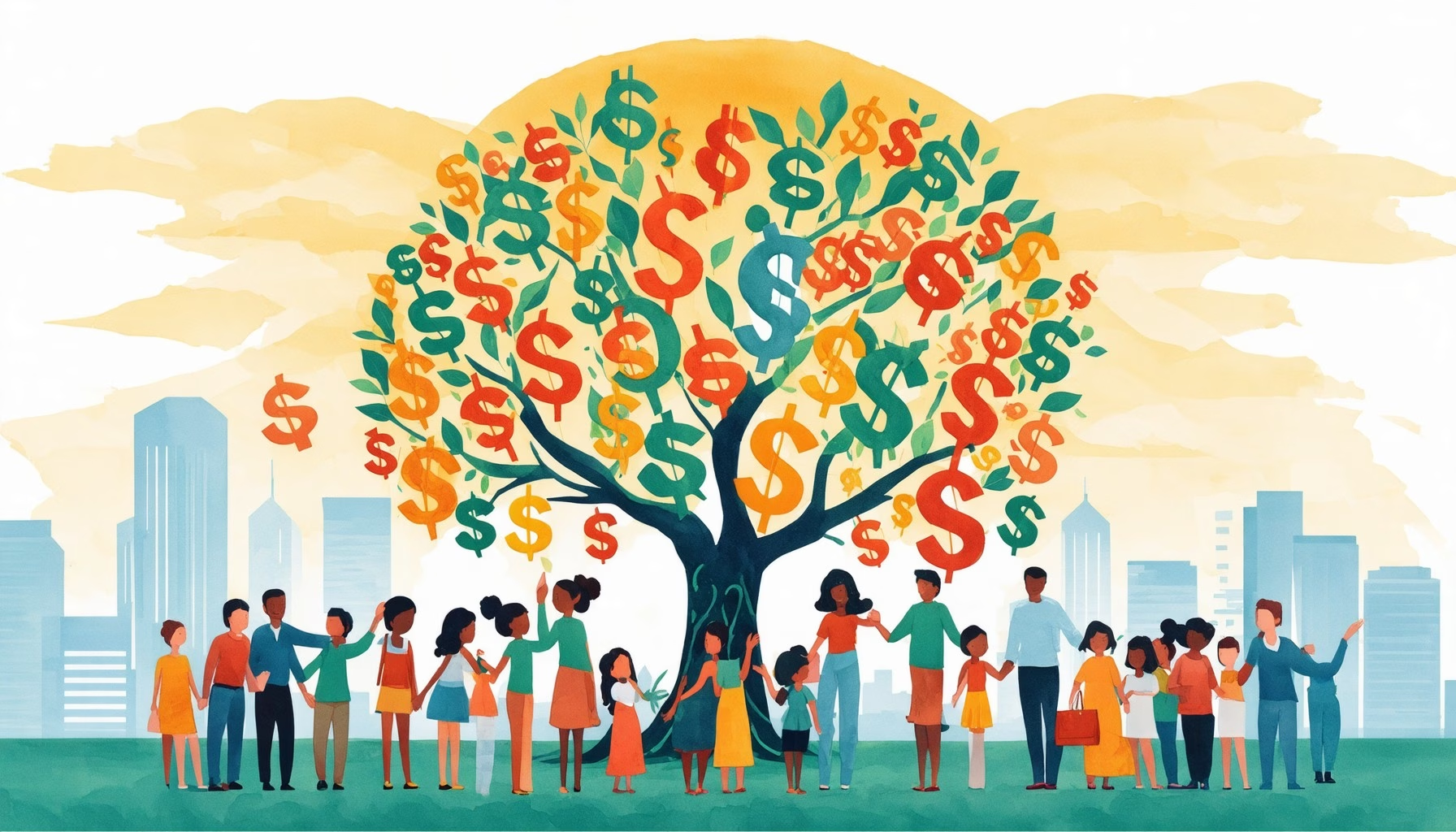Key Takeaways
- Explore various government help programs designed to support low-income families, including housing assistance and financial aid options.
- Access essential resources like the Supplemental Nutrition Assistance Program (SNAP) and Temporary Assistance for Needy Families (TANF) to alleviate financial burdens.
- Utilize state-specific programs for tailored support, such as government assistance in Florida and California’s assistance programs.
- Learn how to apply for assistance through official channels like Benefits.gov to ensure eligibility and access to funds.
- Consider additional resources, such as local nonprofits and community services, to complement government aid and enhance financial stability.
In today’s challenging economic landscape, understanding government help programs is essential for low-income families seeking financial stability. This article will explore the various types of government assistance programs available, including housing assistance, cash aid, and emergency support options. We will delve into critical questions such as, What free stuff can I get from the government? and How can I get money if I’m struggling?, providing insights into the resources that can alleviate financial burdens. Additionally, we will highlight specific programs tailored for different states, including government assistance in Florida and California’s assistance programs. By the end of this article, you will have a comprehensive understanding of how to access these vital resources, ensuring you are well-equipped to navigate the support available for your family’s needs.
What free stuff can I get from the government?
Government help programs offer a variety of resources designed to assist individuals and families in need. These programs aim to alleviate financial burdens and provide essential support across various areas of life. Understanding the different types of government assistance available can empower you to access the help you need.
Overview of Government Help Programs
Government benefits and assistance programs provide a variety of free resources to eligible individuals and families. Here are some key areas where you can access free government support:
- Food Assistance: Programs like the Supplemental Nutrition Assistance Program (SNAP) offer financial assistance for purchasing food. According to the USDA, SNAP helps millions of Americans afford nutritious food.
- Health Insurance: The Affordable Care Act (ACA) provides options for free or low-cost health insurance through Medicaid and the Children’s Health Insurance Program (CHIP). These programs are designed to ensure that low-income families have access to necessary medical care.
- Housing Assistance: The U.S. Department of Housing and Urban Development (HUD) offers various programs, including public housing and housing choice vouchers, to help low-income individuals secure affordable housing. For more information on housing assistance programs, visit government assistance for housing.
- Utility Assistance: The Low Income Home Energy Assistance Program (LIHEAP) helps families pay their heating and cooling bills. This program is crucial for ensuring that households can maintain a safe and comfortable living environment.
- Welfare and Financial Assistance: Temporary Assistance for Needy Families (TANF) provides financial aid to families with children in need. This program aims to help families achieve self-sufficiency through job preparation and work opportunities.
- Social Security Benefits: Social Security provides financial support to retirees, disabled individuals, and survivors of deceased workers. This program is a vital resource for many Americans.
- Government Checks and Payments: Various programs offer direct payments to eligible individuals, such as unemployment benefits and stimulus checks during economic downturns.
For more detailed information on these programs and to determine eligibility, you can visit USAGov or consult local government websites. These resources can guide you through the application process and help you access the benefits you may qualify for.
Types of Government Assistance Programs Available
There are numerous government assistance programs tailored to meet the diverse needs of the population. Here are some of the main types of programs available:
- Housing Assistance Programs: These programs are designed to help low-income families secure affordable housing. Options include public housing, housing choice vouchers, and various subsidy programs. For more insights into housing assistance, check out housing assistance programs.
- Financial Assistance Programs: These programs provide cash assistance to individuals and families facing financial hardship. They include government cash assistance programs, welfare benefits, and emergency help with mortgage payments. For more information on financial aid, visit government assistance programs.
- Healthcare Assistance Programs: Programs like Medicaid and CHIP ensure that low-income families have access to necessary medical care. These programs help cover medical expenses and provide essential health services.
- Utility Assistance Programs: These programs help families manage their utility bills, ensuring they can maintain a safe living environment. LIHEAP is a key program in this category.
Understanding these types of government assistance programs can help you identify the support you may be eligible for and how to apply for it effectively.

How can I get money if I’m struggling?
If you’re struggling financially, there are several avenues you can explore to obtain assistance:
- Reach Out to Family and Friends: Personal connections can provide immediate support. Be transparent about your situation and consider discussing repayment options if you borrow money.
- Sell Unwanted Items: Look around your home for items you no longer need. Platforms like eBay, Facebook Marketplace, and Craigslist can help you sell these items quickly, providing you with cash.
- Consider a Personal Loan: Research local banks, credit unions, or online lenders that offer personal loans. Ensure you understand the terms, interest rates, and repayment plans before committing.
- Credit Card Cash Advance: If you have a credit card, you may be able to take a cash advance. Be cautious, as interest rates on cash advances can be high, and fees may apply.
- Request an Advance from Your Employer: If you’re currently employed, consider asking your employer for a paycheck advance. This can be a straightforward solution if your employer is open to it.
- Explore Government Assistance Programs: Various government programs can provide financial aid, food assistance, and housing support. Websites like Benefits.gov can help you identify programs you may qualify for based on your situation.
- Nonprofit Organizations: Many nonprofits offer financial assistance, counseling, and resources for those in need. Organizations like the Salvation Army or local community action agencies can provide support.
- Freelancing or Gig Work: Consider taking on freelance work or gig jobs (like driving for rideshare services or delivering food) to generate additional income quickly.
- Financial Counseling: Seek advice from a certified financial counselor who can help you create a budget, manage debt, and explore options for financial relief.
By utilizing these strategies, you can find ways to alleviate your financial struggles effectively. Always ensure to research and understand the implications of any financial decision you make.
Government Cash Assistance Programs Explained
Government cash assistance programs are designed to provide financial support to individuals and families facing economic hardship. These programs can help cover essential expenses such as food, housing, and healthcare. Some of the most notable government assistance programs include:
- Temporary Assistance for Needy Families (TANF): This program provides cash assistance to low-income families with children, helping them meet basic needs while promoting self-sufficiency.
- Supplemental Security Income (SSI): SSI offers financial assistance to individuals with disabilities or those aged 65 and older who have limited income and resources.
- General Assistance Programs: Many states offer general assistance programs that provide cash aid to low-income individuals and families who do not qualify for other forms of assistance.
To apply for these programs, visit your state’s social services website or USA.gov for more information on eligibility and application procedures.
What are some things the government can help pay for?
Government help programs are designed to provide essential support for individuals and families facing financial challenges. Among these, housing assistance programs play a crucial role in ensuring that low-income families have access to safe and affordable housing. Understanding the various types of assistance available can empower you to take advantage of these resources effectively.
Housing Assistance Programs for Low-Income Families
Housing assistance programs are vital for low-income families seeking stable living conditions. These programs can include:
- Public Housing: Managed by local housing authorities, public housing offers affordable rental options for eligible low-income families, the elderly, and individuals with disabilities.
- Section 8 Housing Choice Voucher Program: This program allows families to rent privately-owned homes while receiving rental assistance to cover a portion of their rent.
- Transitional Housing Programs: Designed for families experiencing homelessness, these programs provide temporary housing and supportive services to help them secure permanent housing.
For more information on housing assistance programs, you can visit the U.S. Department of Housing and Urban Development.
Mortgage Assistance Grants and Subsidy Programs
Mortgage assistance programs are essential for homeowners struggling to make their mortgage payments. These programs can provide financial relief through:
- Mortgage Assistance Grants: These grants help cover mortgage payments for eligible homeowners facing financial hardship, ensuring they can remain in their homes.
- Subsidy Programs: These programs offer financial assistance to reduce monthly mortgage payments, making homeownership more affordable.
- Emergency Help with Mortgage Payments: In times of crisis, such as job loss or medical emergencies, homeowners can access emergency funds to prevent foreclosure.
To explore available mortgage assistance options, check out the emergency help with mortgage payments resource.
Where can I ask for help with money?
If you’re seeking financial assistance, it’s essential to know where to turn for help. Various resources are available, particularly through government assistance programs designed to support individuals and families in need. In this section, we will explore specific resources for government assistance in Florida and California, two states with numerous programs aimed at alleviating financial hardship.
Resources for Government Assistance in Florida
Florida offers a range of government assistance programs to help residents facing financial difficulties. Here are some key resources:
- Florida Department of Children and Families (DCF): This agency administers several assistance programs, including Temporary Assistance for Needy Families (TANF) and Supplemental Nutrition Assistance Program (SNAP). You can learn more about these programs on the Florida DCF website.
- Florida Low-Income Home Energy Assistance Program (LIHEAP): This program provides financial assistance to help low-income households with their energy bills. More information can be found on the Access Florida website.
- Community Action Agencies: These local organizations offer various services, including housing assistance, food programs, and utility help. You can find a list of agencies in your area through the Florida Community Action website.
How to Access Government Assistance Programs in California
California residents can also benefit from numerous government assistance programs. Here’s how to access them:
- California Department of Social Services (CDSS): This department oversees programs like CalWORKs and CalFresh, which provide cash assistance and food benefits. Visit the CDSS website for more information.
- California Housing Finance Agency (CalHFA): For those needing help with housing, CalHFA offers various programs, including mortgage assistance programs and grants to help pay mortgage. More details can be found on the CalHFA website.
- Local Nonprofits and Charities: Organizations such as the United Way and local food banks provide essential services and financial assistance. Check the United Way website for resources in your area.

How can I get money from the government right now?
Emergency Help with Mortgage Payments
To access emergency help with mortgage payments, several government assistance programs are available to provide immediate relief to homeowners facing financial difficulties. These programs aim to prevent foreclosure and ensure that families can remain in their homes during challenging times. Here are some key options:
1. **Homeowner Assistance Fund (HAF)**: This federal program offers financial assistance to homeowners who are struggling to make mortgage payments due to the COVID-19 pandemic. Eligible homeowners can receive funds to cover past due mortgage payments, property taxes, and homeowners insurance. Check your state’s housing agency for application details.
2. **Mortgage Assistance Programs**: Various state-specific mortgage assistance programs exist to help low-income families. These programs may offer grants or low-interest loans to cover missed payments. For example, the U.S. Department of Housing and Urban Development (HUD) provides resources to find local programs tailored to your needs.
3. **Emergency Rental Assistance**: If you are unable to pay your mortgage due to loss of rental income, you may qualify for emergency rental assistance programs. These programs can provide funds to landlords, helping you avoid eviction and maintain your housing stability.
4. **Government Relief Programs**: Many states have implemented their own relief programs to assist homeowners. These programs often include financial aid for mortgage payments, utility bills, and other housing-related expenses. Visit your state’s official website for more information on available assistance.
For more detailed information on emergency help with mortgage payments, you can explore resources from [HUD](https://www.hud.gov/) and [Benefits.gov](https://www.benefits.gov/).
Fast-Track Government Assistance Programs for Immediate Needs
If you need immediate financial assistance, several fast-track government assistance programs can help you access funds quickly. Here are some options to consider:
1. **Unemployment Insurance (UI) Benefits**: If you have lost your job or had your hours reduced, you may qualify for unemployment benefits. These benefits provide cash payments based on your previous earnings. Apply through your state’s unemployment office, ensuring you have your employment history and identification ready.
2. **Economic Impact Payments (Stimulus Checks)**: The federal government has issued multiple rounds of stimulus checks to eligible individuals and families. Check your eligibility based on your adjusted gross income (AGI) from your most recent tax return. If you haven’t received your payment, you can claim it when you file your taxes.
3. **Temporary Assistance for Needy Families (TANF)**: This program provides financial assistance to low-income families with children. Eligibility varies by state, so check with your local social services agency for application details.
4. **Local and State Assistance Programs**: Many states and local governments offer emergency financial assistance programs for residents facing financial hardship. Check your local government’s website for available resources.
For further reading and assistance, visit [Gov Guider](https://govguider.com/) for resources and guidance on accessing government benefits and financial aid. Always ensure you are applying through official government websites to avoid scams.
What are the three biggest programs that assist low-income people?
The three biggest programs that assist low-income individuals in the United States are:
- Temporary Assistance for Needy Families (TANF): TANF provides financial assistance and support services to low-income families with children. The program aims to help families achieve self-sufficiency through job preparation, work, and marriage. According to the U.S. Department of Health & Human Services, TANF offers states flexibility in designing their programs, which can include cash benefits, childcare assistance, and job training.
- Supplemental Security Income (SSI): SSI is a federal program that provides financial assistance to individuals who are aged, blind, or disabled and have limited income and resources. The Social Security Administration administers SSI, ensuring that recipients can meet their basic needs for food, clothing, and shelter. As of 2023, the maximum federal benefit for an individual is $914 per month, which can vary based on state supplements.
- Earned Income Tax Credit (EITC): The EITC is a refundable tax credit designed to benefit low- to moderate-income working individuals and families, particularly those with children. The credit reduces the amount of tax owed and may result in a refund. According to the Internal Revenue Service, the EITC can significantly increase the income of eligible families, thereby reducing poverty and encouraging work.
Comparison of Government Housing Programs and Benefits
Government housing programs play a vital role in providing assistance to low-income families and individuals. Here’s a comparison of some key government housing programs:
- Public Housing: Managed by local housing authorities, public housing provides affordable rental options for low-income families. Eligibility is based on income, and tenants typically pay 30% of their income towards rent.
- Section 8 Housing Choice Voucher Program: This program allows low-income families to rent privately owned homes with the help of government subsidies. Participants can choose their housing, and the government pays a portion of the rent directly to the landlord.
- Low-Income Home Energy Assistance Program (LIHEAP): While primarily focused on energy costs, LIHEAP also assists with housing stability by providing financial aid to low-income households for heating and cooling expenses, ensuring that families can maintain safe living conditions.
For more information on government assistance for housing, visit this resource.
Conclusion: Navigating Government Help Programs for Financial Stability
Understanding and accessing government help programs is crucial for individuals and families seeking financial stability. These programs provide essential support, whether through direct cash assistance, housing aid, or emergency relief. By familiarizing yourself with the available resources, you can take significant steps toward improving your financial situation.
Steps to Apply for Government Assistance Programs
Applying for government assistance programs can seem daunting, but following a structured approach can simplify the process:
- Identify Your Needs: Determine what type of assistance you require, such as government assistance for housing or government cash assistance programs.
- Research Available Programs: Utilize resources like Benefits.gov to find programs that match your needs.
- Gather Required Documentation: Collect necessary documents such as proof of income, identification, and any other relevant information.
- Complete the Application: Fill out the application forms accurately and submit them through the designated channels, whether online or in person.
- Follow Up: After submission, monitor the status of your application and respond promptly to any requests for additional information.
Future Resources and Support for Low-Income Families
As you navigate the landscape of government assistance programs, it’s essential to stay informed about future resources that can provide ongoing support:
- Local Community Services: Many communities offer additional resources, such as food banks and job training programs, which can complement housing assistance.
- State-Specific Programs: Each state has unique government assistance programs tailored to local needs. Check your state’s official website for updates.
- Nonprofit Organizations: Organizations like the United Way and local charities often provide financial assistance and can help connect you with subsidy programs.




